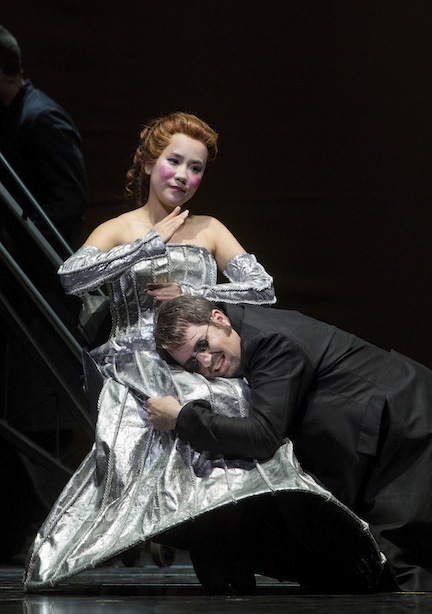
Making fantasy live and sing
A vocally dazzling cast presented Offenbach’s wonderful and fantastically storied opera “The Tales of Hoffmann” as part of San Francisco Opera’s summer season. Tenor Michael Polenzani was delicious in the title role of the poet Hoffmann. His voice has grown since the last time he set foot on the San Francisco Opera House stage, becoming larger and more resonant, full of that emotional vibrance that makes tenors the coveted darlings they are. He is both innocent and petulant, his voice shot with romantic desire, hovering just a fevered step past male reserve. That more repressed form of masculinity is saved for bass-baritone Christian Van Horn, who sings the poet’s evil nemesis, and he delivers it perfectly in deep round tones from his exalted height, which must be somewhere around 6 foot 4 inches.
The women of the production are equally impressive. The three versions of Hoffmann’s unrequited love are sung by Hye Jung Lee, stratospheric in her rendition of the mechanical doll Olympia, Natalie Dessay, who uses her gorgeous lyric tones in the role of the young girl Antonia who sings herself to her death, and Irene Roberts who sings Giulietta, the mercenary courtesan who is willing to capture Hoffmann’s soul in the devil’s mirror. These sopranos have a heart-gripping range of pure tone differently placed in each voice, which was fascinating to hear. Mezzo-soprano Angela Brower acquitted herself admirably as Hoffmann’s Muse and comrade Nicklausse. Soprano Jacqueline Piccolino, a current Adler Fellow, sang the role of Stella, the opera singer who is the summation of Hoffmann’s three lost loves.
“The Tales of Hoffmann”, based on an 1851 play that combines four stories from the work of early Romantic fantasist E.T.A. Hoffmann, had the misfortune of being Offenbach’s last opera. He died before its completion, leaving its complicated story and music in some disarray. The version used by San Francisco Opera is the most recent reconstruction, assembled by Michael Kaye and Jean-Christophe Keck for the 2003 production in Lausanne. This version adds, among other things, spoken dialog that clarifies the plot of the story. It helps to link the originally independent stories to the overall structure, which presents the poet, or artist, in a struggle with his muse. Will concerns of the body—love in all its time-consuming insistence—keep the artist from his art? This isn’t a problem that either Hoffmann or Offenbach seemed to suffer from. Whatever their love lives, both men were ferociously prolific. Offenbach created over 100 stage productions in his 61 years of existence.
French director and designer Laurent Pelly designed the production. Pelly was responsible for the 2009 “La Fille du Régiment” starring Diana Damrau and Juan Diego Flórez. Both productions emphasized a range of grays, but where “La Fille” was unceasingly fun and light in its presentation, using the neutrality of the color to emphasize splashes of red and bright colors, the grays of “Tales of Hoffmann” brood, suggesting the ever shadowy presence of evil. The geometric sets move, closing down in sharp angles and leading us into the dark corners of dreams gone wrong. The production is pitch perfect for this complex and fascinating opera.
—Jaime Robles
Photo: Hye Jung Lee (Olympia) and Matthew Polenzani (Hoffmann) in San Francisco Opera’s “The Tales of Hoffmann”. ©Cory Weaver/San Francisco Opera.
